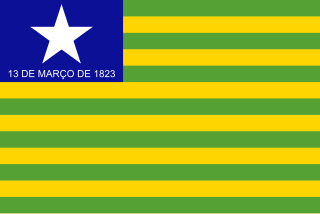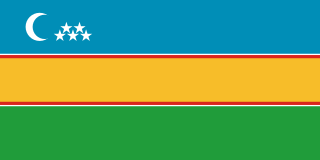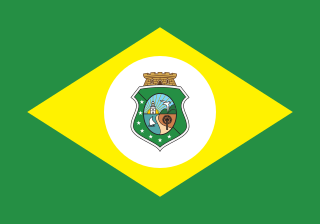
The flag of Europe or European flag consists of twelve golden stars forming a circle on a blue field. It is the official flag of the European Union. It was designed and adopted in 1955 by the Council of Europe (CoE) as a symbol for the whole of Europe.

The State Flag of the Union of Soviet Socialist Republics, also simply known as the Soviet flag or the Red Banner, was a red flag with two communist symbols displayed in the canton: a gold hammer and sickle topped off by a red five-point star bordered in gold. The flag's design and symbolism are derived from several sources, but emerged during the Russian Revolution. It has also come to serve as the standard symbol representing communism as a whole, recognized as such in international circles, even after the dissolution of the Soviet Union in 1991.

Sergipe, officially State of Sergipe, is a state of Brazil. Located in the Northeast Region along the Atlantic coast of the country, Sergipe is the smallest state in Brazil by geographical area at 21,910 square kilometres (8,460 sq mi), larger only than the Federal District. Sergipe borders Bahia to the south and west and Alagoas to the north. Aracaju is the capital and the largest city in the state; the state is divided into 75 municipalities. The state has 1.1% of the Brazilian population and produces only 0.6% of the Brazilian GDP.

The national flag of Brazil is a blue disc depicting a starry sky spanned by a curved band inscribed with the national motto Ordem e Progresso, within a yellow rhombus, on a green field. It was officially adopted on 19 November 1889 –four days after the Proclamation of the Republic, to replace the flag of the Empire of Brazil. The concept was the work of Raimundo Teixeira Mendes, with the collaboration of Miguel Lemos, Manuel Pereira Reis and Décio Villares.

The national flag of the Plurinational State of Bolivia was originally adopted in 1851. The state and war flag is a horizontal tricolor of red, yellow and green with the Bolivian coat of arms in the center. According to one source, the red stands for Bolivia's brave soldiers, while the green symbolizes fertility and yellow the nation's mineral deposits.

The flag ofthe state of New Mexico, also referred to as the New Mexican flag, is a State flag, consisting of a sacred red sun symbol of the Zia tribe on a field of gold (yellow). It was officially adopted in March 15, 1925 to highlight the state's Indigenous and Hispanic heritage: it combines the symbol of Puebloan people, who have ancient roots in the state, with the colors of the flag of Spain, symbolizing the Spanish empire, which had established and ruled over “Nuevo México” for over two and a half centuries.

A red star, five-pointed and filled, is a symbol that has often historically been associated with communist ideology, particularly in combination with the hammer and sickle, but is also used as a purely socialist symbol in the 21st century. It has been widely used in flags, state emblems, monuments, ornaments, and logos.

A five-pointed star (☆), geometrically an equilateral concave decagon, is a common ideogram in modern culture. Comparatively rare in classical heraldry, it was notably introduced for the flag of the United States in the Flag Act of 1777 and since has become widely used in flags.

The flag of the Republic of Bashkortostan is one of the official state symbols of Bashkortostan, a federal subject of Russia, alongside the coat of arms and anthem. The flag has three horizontal stripes. From top to bottom, the stripes are teal blue, white, and green. The flag has been used officially as the flag of the Republic of Bashkortostan since 25 February 1992. The white stripe of the flag is charged with a kurai flower in the center.

The national flag of the People's Republic of China, also known as the Five-star Red Flag, is a Chinese red field with five golden stars charged at the canton. The design features one large star, with four smaller stars in an arc set off towards the fly. It has been the national flag of China since the foundation of the People's Republic of China on 1 October 1949. The flag was designed by Zeng Liansong.
Communist symbolism represents a variety of themes, including revolution, the proletariat, the peasantry, agriculture, or international solidarity. The red flag, the hammer and sickle and the red star or variations thereof are some of the symbols adopted by communist movements, governments, and parties worldwide.

The current state flag of Acre was introduced by Law No. 1170 of 22 December 1995, adopting the design of the flag of the Republic of Acre, as modified by Resolution No. 5 of 24 January 1921. The faixa governamental used by the Chief Executive of Acre is made up of the colors of the flag, and also boasts the red star.

The flag of Piauí is one of the official symbols to the state of Piauí, in Brazil.

The flag of the state of São Paulo, Brazil, serves as one of the state's symbols, along with the state's coat of arms and anthem. It was designed by the philologist and writer Júlio Ribeiro in 1888, with his brother-in-law, Amador Amaral, a graphic artist. The flag has thirteen black and white stripes and a red rectangle in the upper left corner holding a white circle enclosing an outline map of Brazil in blue. There is a yellow star in each corner of the red rectangle.

The state flag of Karakalpakstan is one of the official symbols of Karakalpakstan, an autonomous republic within Uzbekistan. It was designed from a sketch by Karakalpak artist Zhollybai Izentaev. The flag is based on the flag of Uzbekistan.

The flag of Ceará is the official flag of the Brazilian state of Ceará. The original version of the flag was adopted on 25 August 1922 by state decree 1,971 of Ceará.

The state flag of Mato Grosso do Sul was designed by a group of University of São Paulo students and adopted on 1 January 1979 by the 1st decree of the state of Mato Grosso do Sul.

The flag of Rio Grande do Sul is the official flag of the Brazilian state of Rio Grande do Sul.



















